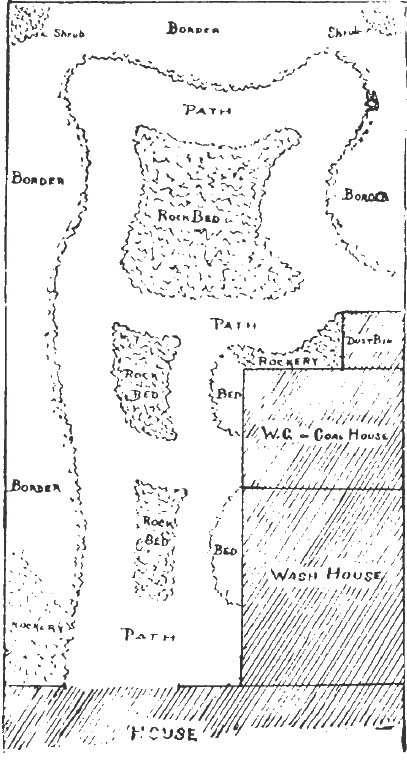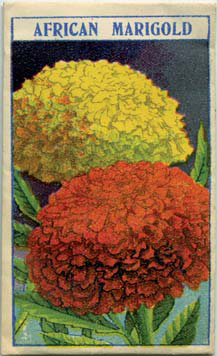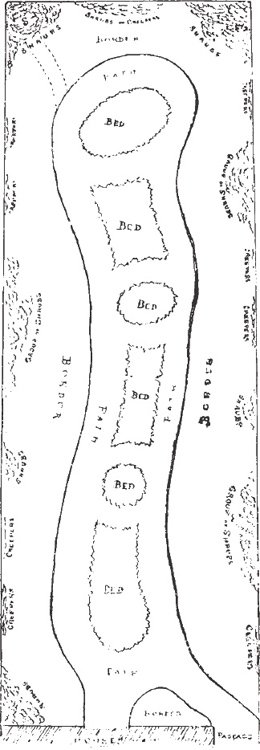 Small Gardens
Small Gardens 
 Small Gardens
Small Gardens 
Asmall garden may be roughly estimated to include backyards, designated by the immortal author of “Pickwick” as “enclosed bits of dirt”; those narrow strips, ten feet in width and twenty to thirty feet in length, enclosed with open palings, and frequently seen in a congested area like the East End of London. It also includes those slightly larger and more respectable looking plots attached to the average villa in the suburbs. And besides these, those still larger gardens of a quarter of an acre or so which exist on the outskirts of suburbs, and are somewhat palatial as compared with the preceding ones.
 Backyard Gardens
Backyard Gardens 
A backyard! Is it really possible to make these unlovely spots beautiful? This is a question very frequently put to the writer in his editorial capacity. We say that it is quite practicable to ensure a beautiful garden in ninety-nine cases out of every hundred, providing the task is performed in the right way. It is really astonishing what may be done at a little cost, and with a little taste and labour, in the way of beautifying dreary spots. Instead of a narrow border, with pieces of rotten board for an edging, procure some burrs, clinkers, or flints, and form a border, with an irregular outline, all round the yard. Let this border vary in width from one to four or five feet, and, if it terminate in a shady corner, form there a rockery. In the centre form one or two roundish or oval beds, with outlines of burrs, flints, or broken bricks, and then you have the groundwork of a pretty garden [see Plan I opposite]. Dig the soil two or three spits deep, work in plenty of horse manure, also ashes, if the soil be clayey. If at all sour, dig in lime, using a spadeful to a square yard. When the ground is dug, plant creepers to cover the side and end walls. The Virginian creeper (Ampelopsis hederacea) and Raegner’s ivy are good kinds for a shady north or east wall; and Clematis Jackmanii, Jasminum nudiflorum, and variegated ivies, for sunny west and south walls. Plant these between October and March. Do not attempt to grow roses; they require more air and sunshine than is possible in a backyard.
If you have room for a shrub or two, plant Aucuba japonica or Euonymus japonica as evergreens; and the Mock Orange (Philadelphus coronarius) or Flowering Currant (Ribes sanguineum) as deciduous ones. In the sunny borders plant in autumn or spring such hardy perennials as the Golden Rod (Solidago virgaurea), early flowering Chrysanthemums, Tradescantia virginiana, Lilium candidum, Lilium tigrinum, Goat’s Rue (Galega officinalis), London Pride, and Creeping Jenny. In the shady borders, Lily of the Valley, Solomon’s Seal, Saxifraga cordifolia purpurea, hardy British ferns, Periwinkle, London Pride, Creeping Jenny, and Stonecrop will grow. The list is a short one, but it is always better to grow a few kinds in large quantities really well than a dozen that only eke out a miserable existence. In April sow some of the excellent One & All hardy annual seeds in vacant spaces, and plant out a few Zonal Pelargoniums, Petunias, Ten-Week Stocks, African Marigolds, and Lobelia in sunny spots, and Calceolarias, French Pansies, Musk, and Monkey Flowers in the shady ones. If space permits, Dahlias may be planted, but these require plenty of sun. When autumn arrives, plant bulbs, especially Crocus, Tulips, Hyacinths, Daffodils, Scillas, and Snowdrops. Seeds of annual climbers, like the Japanese Hop and the Canary Creeper, may be sown at the foot of a shady wall or fence, and those of the common or tall Nasturtium and the tall Convolvulus at the base of sunny walls. These creepers will quickly cover a large space, and add to the beauty of the garden.

Plan I
There are other ways of making the backyard attractive. A dustbin, for example, may be partly screened from view by a piece of expanding trellis, painted green. A few seeds of Nasturtium, Canary Creeper, or Japanese Hop, sown at the base in April, will result eventually in a complete living screen of foliage and flowers, and look remarkably pretty. A dry, ugly corner may be beautified by placing a heap of mould therein, dropping a few pieces of broken flint or burr on the surface to form tiny beds, and planting these with Stonecrop, Houseleek, and London Pride. A shady, moist corner can be similarly treated, planting Ferns and Creeping Jenny in addition to the other plants. The space between the beds may be composed of cinders, gravel, ballast, concrete, or asphalt, according to taste and means. Above all things, avoid the hideous practice of whitewashing flints, using coloured glass, or dotting oyster and other white shells about; they look common, hideous, and Cockneyfied, and should never be seen in a garden of taste. Arrange or plant everything naturally; avoid straight lines and rows of plants; plant in groups or masses; and have the outlines of the beds as irregular as possible. Tolerate no bare walls; plant perennial or evergreen Creepers; and try in every way to make the wall look green, if nothing more.


Dahlias
 Small Villa Gardens
Small Villa Gardens 
But we must hark away to the larger type of gardens or we shall not be able to carry out our programme fully [see Plan II overleaf]. These, we will assume, are not hedged in with lofty buildings, obscuring the light, shutting out sunshine, and preventing the access of fresh air, but are fairly open; such gardens as these will grow a greater variety of plants, and be productive of greater interest to their owners, than a backyard, however well managed and tended.

The Editor’s charming back garden in Lewisham, c. 1905
Here also straight walks and borders with board edgings should be avoided. Burrs, broken bricks, flints, or clinkers should be employed for edgings, and the borders and beds should have irregular outlines. The side fences, if open, may be utilised for growing Scarlet-runner Beans in summer. These will look pretty when in bloom, while their pods will be useful for cooking later on. The borders can be planted with hardy perennials like the perennial Sunflower, Larkspur, Lupin, Lilies of sorts, Pæonies, Chrysanthemums, Sweet Williams, Carnations, and Violas on the sunny sides; and perennial Phloxes, Anemone japonica, Michaelmas Daisies, Golden Rod, Lilium auratum, Solomon’s Seal, Lilies of the Valley, Pansies, London Pride, Creeping Jenny, Stonecrop, and Auriculas on the shady ones. In April hardy annuals, such as Sunflowers, Cornflowers, annual Chysanthemums, Mignonette, Coreopsis, Candytuft, and Lupins may be sown in patches in the sunny parts; and Virginian Stock, Dwarf Nasturtiums, Love-in-a-Mist, Prince’s Feather, and the common Balsam (Impatiens glandulifera) in the shady spots.

Plan II
The beds, if any, can be planted with seedling African Marigolds, Ten-Week Stocks, China Asters, Zinnias, Phlox Drummondi or Indian Pinks, or with Zonal Pelargoniums, Fuchsias, Marguerites, and the like. Bulbs can of course be planted in autumn, and if desired, a few evergreens or deciduous shrubs. Supposing that Runner Beans are not cared for, sow good patches of tall Nasturtiums, Canary Creeper, Japanese Hop, tall Convolvulus, and Sweet Peas, and let these run up the fence. The house walls, if shady, can be planted with Virginian Creeper and Raegner’s Ivy; the sunny ones with Ampelopsis Veitchii and Clematis Jackmanii. Ugly corners can be beautified by means of a rockery planted with hardy ferns, Periwinkle, London Pride, and Creeping Jenny, if shady; and a few shrubs and flowers if sunny. Window sills, too, may be made attractive in the same way and with similar materials to those described in connection with the backyard garden.

Plan III
 Moderate Villa Gardens
Moderate Villa Gardens 
And now we come to the larger garden, surrounded by walls or fences, fairly well exposed, and providing room for the growth of flowers and a few vegetables [see Plan III]. Here there is abundant scope for anyone to make the most of their resources, and ensure not only a pretty but a profitable and useful garden. As a general rule, the boundary walls or fences are not utilised profitably. In many instances they are bare and unfurnished with creepers or fruit trees; in others the climbers are unsuitable, and therefore useless, and hence valuable space is wasted. Most of these boundary walls or fences do not exceed five feet in height. To plant espalier or fan-trained fruit-trees against these is sheer folly and crass stupidity, since in a year or so after planting the trees reach the top of the wall, or fence, and if close pruning is resorted to in order to keep them within due bounds, they invariably make rank growth, become unfruitful, and a rendezvous for insect pests of all kinds. Away with such trees, then; they only encumber the ground. If fruit-trees are required, plant the cordon form of tree, which has one stem and fruit spurs along its entire length. These, planted at an angle of 45 degrees, and 18 inches apart, will not outgrow their limits, will bear freely, be easy to manage, and in every way better for the purpose. Apples, Pears, Plums, Cherries, Gooseberries, and Currants can be obtained trained in this way from 1s. to 1s. 6d. each. Pears do best on a south aspect; Apples, Plums, and Cherries on an east and west aspect; and Gooseberries and Currants on a north aspect. If fruit is not required, then plant the south wall or fence with Tea and Noisette Roses; the north ones with the Fire-thorn (Cratægus pyracantha), a beautiful berry-bearing shrub; Cotoneaster microphylla, another berried evergreen; the Boursault, and the evergreen Roses and Clematis vitalba; the east with variegated ivies, Japanese Quince (Cydonia japonica), and Clematis Jackmanii; the west with Jasminum nudiflorum, the Gold-netted Honeysuckle (Lonicera brachypoda aurea-reticulata – a remarkably long name, by the way, for so simple and pretty a plant), the fragrant winter-flowering Chimonanthus fragrans, Berberis stenophylla, and some of the Clematis. These would afford a great variety of colour, and be of interest in all seasons.